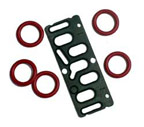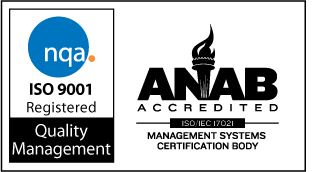
|
7108
S. Alton Way, Unit I |
(303) 758-2728
Oil Seals
Note: We have many types of standard oil seals and specialty oil seals, so please call so we can help you pick out exactly what you need.
In terms of overall seal design, the following will give a brief explanation of some of the broad oil seal categories we commonly work with. Oil seals are classified according to the sealing element and the structure. The classification by sealing element corresponds to the first letter in the oil seals P/N style. The classification by structure corresponds to the second letter.
Classification by Element:
S: Standard oil seals with a single sealing lip design. They are used to seal against internal media.
Limitations: Peripheral Speed: 12 m/sec
Temperature: 120°C (250°F)
Pressure: 0.3 Kg/cm2 (5-10 psi)T: Oil seals with a double sealing lip design. The main lip seals against internal media, while the auxiliary lip (dust lip) provides protection against external dirt and dust.
Limitations: Peripheral Speed: 10 m/sec
Temperature: 120°C (250°F)
Pressure: 0.3 Kg/cm2 (5-10 psi)V: An oil seal design where no spring is loaded. The flexible sealing element is used to seal internal media. It is suitable for sealing grease and protecting against dirt and dust. It can also be used along with other types of seals.
Limitations: Peripheral Speed: 8 m/sec
Temperature: 120°C (250°F)
Pressure: 0 Kg/cm2 (3 psi)K: Oil seals where no spring is loaded. The flexible sealing element is used to seal against both internal and outer media and provides protection against dirt and dust.
Limitations: Peripheral Speed: 5 m/sec
Temperature: 120°C (250°F)
Pressure: 0 Kg/cm2 (3 psi)D: This oil seal style is intended for sealing against both internal and external media. It is usually used to separate two liquids. The area between the two lips must be lubricated with grease, etc.
Limitations: Peripheral Speed: 5 m/sec
Temperature: 120°C (250°F)
Pressure: 0.3 Kg/cm2 (5-10 psi)TX4: This design for oil seals is intended for reciprocating motion (not for rotary), especially for pressurized media.
Limitations: Reciprocating Speed: 0.3m/sec
Temperature: 120°C (250°F)
Pressure: 7Kg/cm2 (100 psi)Classification by Structure:
Code Characteristics C A rubber covered case - can be used on any shaft size. It prevents the metal case from rusting, corrosion, and prevents damage to the housing bore during assembly. Also, it is the most effective structure design to prevent bore leakage in oil seals. B/BX2 A metal case - mainly used on shafts for which the diameters are below 150 mm. A/AX2 A reinforced case - mainly used on shafts larger than 150 mm, or smaller shafts that require extra strength in the metal case. BC Rubber covered "end-cap" plug - solid caps and no center hole. For sealing additional shaft location holes (shaft added later). For multiple hole housings requiring seal plug for unused shaft holes.
Back to Product Information O-rings and Seals
We are located in the Denver Technological
Center in a suburb of Denver, Colorado
©1997-2017, Problem Solving Products, Inc.
Website Map | Privacy Statement
| Terms of Use







